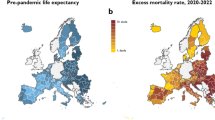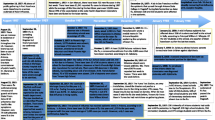Abstract
Estimates of worldwide mortality from the influenza pandemic of 1918–1919 vary widely, from 15 million to 100 million. In terms of loss of life, India was the focal point of this profound demographic event. In this article, we calculate mortality from the influenza pandemic in India using panel data models and data from the Census of India. The new estimates suggest that for the districts included in the sample, mortality was at most 13.88 million, compared with 17.21 million when calculated using the assumptions of Davis (1951). We conclude that Davis’ influential estimate of mortality from influenza in British India is overstated by at least 24%. Future analyses of the effects of the pandemic on demographic change in India and worldwide will need to account for this significant downward revision.


Similar content being viewed by others
References
Afkhami, A. (2003). Compromised constitutions: The Iranian experience with the 1918 influenza pandemic. Bulletin of the History of Medicine, 77, 367–392.
Almond, D. (2006). Is the 1918 influenza pandemic over? Long–term effects of in utero influenza exposure in the post–1940 U.S. population. Journal of Political Economy, 114, 672–712.
Census of India. (Various years). Calcutta, India: Superintendent, Government Printing.
Davis, K. (1951). The population of India and Pakistan. Princeton, NJ: Princeton University Press.
Government of India. (1920). Annual report of the Sanitary Commissioner with the Government of India for 1918. Calcutta, India: Superintendent, Government Printing.
Government of India. (Various years). Annual report of the Sanitary Commissioner with the Government of India. Calcutta, India: Superintendent, Government Printing.
Johnson, N. P. A. S., & Mueller, J. (2002). Updating the accounts: Global mortality of the 1918–1920 “Spanish” influenza pandemic. Bulletin of the History of Medicine, 76, 105–115.
Jordan, E. O. (1927). Epidemic influenza: A survey. Chicago, IL: American Medical Association.
Klein, I. (1973). Death in India, 1871–1921. The Journal of Asian Studies, 32, 639–659.
Klein, I. (1974). Population and agriculture in northern India, 1872–1921. Modern Asian Studies, 8, 191–216.
Klein, I. (1988). Plague, policy and popular unrest in British India. Modern Asian Studies, 22, 723–755.
Klein, I. (1990). Population growth and mortality in British India Part II: The demographic revolution. Indian Economic and Social History Review, 27, 33–63.
Marten, J. T. (1923). Census of India, 1921 (Vol. I, Part I) (Report). Calcutta, India: Superintendent of Government Printing.
Mazumder, B., Almond, D., Park, K., Crimmins, E. M., & Finch, C. E. (2010). Lingering prenatal effects of the 1918 influenza pandemic on cardiovascular disease. Journal of Developmental Origins of Health and Disease, 1, 26–34. doi:10.1017/S2040174409990031
Mills, I. D. (1986). The 1918–1919 influenza pandemic—The Indian experience. Indian Economic and Social History Review, 23, 1–40.
Morens, D. M., Taubenberger, J. K., & Fauci, A. S. (2009). The persistent legacy of the 1918 influenza virus. New England Journal of Medicine, 361, 225–229.
Patterson, K. D., & Pyle, G. (1991). The geography and mortality of the 1918 influenza pandemic. Bulletin of the History of Medicine, 65, 4–21.
SAS Institute, Inc. (2011a). SAS/ETS(R) 9.2 user’s guide: The PANEL procedure. Retrieved from http://support.sas.com/documentation/cdl/en/etsug/60372/HTML/default/viewer.htm#panel_toc.htm
SAS Institute, Inc. (2011b). SAS/STAT(R) 9.2 user’s guide : The MIXED procedure (2nd ed.). Retrieved from http://support.sas.com/documentation/cdl/en/statug/63033/HTML/default/viewer.htm#mixed_toc.htm
Taubenberger, J. K., & Morens, D. M. (2006). 1918 influenza: The mother of all pandemics. Emerging Infectious Diseases, 12, 15–22.
Waring, J. I. (1971). A history of medicine in South Carolina 1900–1970. Columbia: South Carolina Medical Association.
Yeatts, M. W. M. (1943). Census of india, 1941 (Vol. I, Part I) (Report). Simla, India: Government of India Press.
Acknowledgments
This research was made possible by Grant No. 1R21DA025917-01A1 from the National Institute on Drug Abuse (NIDA) of the National Institutes of Health. Its contents are solely the responsibility of the authors and do not necessarily represent the official views of NIDA. The authors would also like to thank participants of the XXXIII Annual Conference of the Indian Association for the Study of Population (IASP) held in Lucknow, India, in 2011, for their input.
Author information
Authors and Affiliations
Corresponding author
Appendices
Appendix 1: List of Districts Used in the Analysis (colonial spellings)
Name | Name | Name | Name | Name | Name |
|---|---|---|---|---|---|
Agra | Budaun | Garhwal | Kanara | Muzaffarpur | Satara |
Ahmedabad | Bulandshahr | Garo Hills | Kangra | Mymensingh | Saugor |
Ahmednagar | Buldana | Gaya | Karachi | Nadia | Shahabad |
Ajmer Merwara | Burdwan | Ghazipur | Karnal | Nagpur | Shahjahanpur |
Akola | Cachar | Goalpara | Kheri | NainiTal | Shahpur |
Aligarh | Calcutta | Godavari East | Khulna | Nasik | Sheikhupura |
Allahabad | Cawnpore | Godavari West | Kistna | Nellore | Sholapur |
Almora | Champaran | Gonda | Kolaba | Nilgiris | Sialkot |
Ambala | Chanda | Gorakhpur | Koraput | Nimar | Sibsagar |
Amraoti | Chhindwara | Gujranwala | Kurnool | Noakhali | Singhbhum |
Amritsar | Chingleput | Gujrat | Lahore | North Arcot | Sitapur |
Anantapur | Chittagong | Guntur | Lakhimpur | Nowgong | SouthArcot |
Attock | Chittoor | Gurdaspur | Larkana | Pabna | South Kanara |
Azamgarh | Coimbatore | Gurgaon | Lucknow | Palamau | Sukkur |
Bahraich | Cuddapah | Hamirpur | Ludhiana | 24 Parganas | Sultanpur |
Bakarganj | Cuttack | Hardoi | Madras | Partabgarh | Surat |
Balaghat | Dacca | Hazaribagh | Madura | Pilibhit | Sylhet |
Balasore | Darbhanga | Hissar | Mainpuri | Poona | Tanjore |
Ballia | Darjeeling | Hooghly | Malabar | Puri | Thana |
Banda | Darrang | Hoshangabad | Malda | Purnea | TharParkar |
Bankura | Dehra Dun | Hoshiarpur | Manbhum | Rae Bareli | Tinnevelly |
BaraBanki | Dera Ghazi Khan | Howrah | Mandla | Raipur | Tippera |
Bareilly | Dharwar | Hyderabad | Meerut | Rajshahi | Trichinopoly |
Basti | Dinajpur | Jalaun | Mianwali | Ramnad | Unao |
Belgaum | Drug | Jalpaiguri | Midnapore | Ranchi | Upper Sind Frontier |
Bellary | East Khandesh | Jaunpur | Mirzapur | Rangpur | Vizagapatam |
Betul | Etah | Jessore | Monghyr | Ratnagiri | Wardha |
Bhagalpur | Etawah | Jhang | Montgomery | Rawalpindi | West Khandesh |
Bhandara | Faridpur | Jhansi | Moradabad | Rohtak | Yeotmal |
Bijapur | Farrukhabad | Jhelum | Multan | Saharanpur | |
Bijnor | Fatehpur | Jubbulpore | Murshidabad | Salem | |
Birbhum | Ferozepore | Jullundur | Muttra | Sambalpur | |
Bogra | Fyzabad | Kaira | Muzaffargarh | Santal Parganas | |
Broach and Panch Mahals | Ganjam | Kamrup | Muzaffarnagar | Saran |
Appendix 2: Details of Random-Coefficients Models
As discussed previously, the general model estimated is
where i and t index districts and time in years. The coefficient estimates π 0i , π 1i , π 2i , and π 3i are defined as
where it is assumed that
and
The coefficients are modeled as varying randomly across districts, and the estimates reported in Table 1 are the mean coefficients across all districts. Details of these models are provided in SAS (2011b).
Rights and permissions
About this article
Cite this article
Chandra, S., Kuljanin, G. & Wray, J. Mortality From the Influenza Pandemic of 1918–1919: The Case of India. Demography 49, 857–865 (2012). https://doi.org/10.1007/s13524-012-0116-x
Published:
Issue Date:
DOI: https://doi.org/10.1007/s13524-012-0116-x




